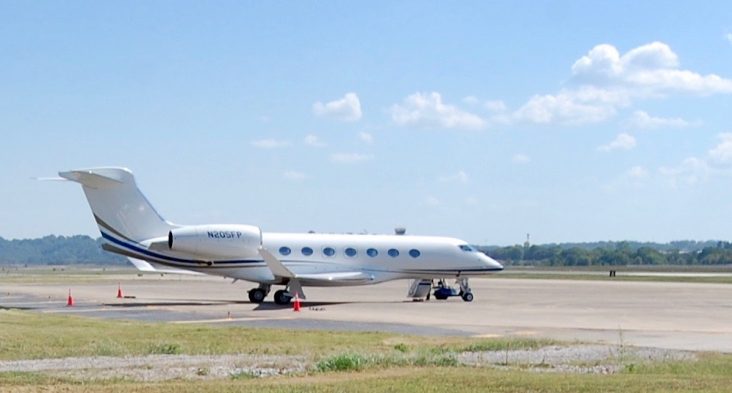Private jets at Fort Smith Regional Airport receiving software fix
by September 19, 2022 3:49 pm 1,944 views

A Gulfstream jet parked at the Fort Smith Regional Airport.
The Gulfstream private jets coming and going from the Fort Smith Regional Airport since Sept. 12 are part of a flight control software fix required by the Federal Aviation Administration and European Union Aviation Safety Agency (EASA) to address a flight control problem.
According to an FAA directive issued Sept. 8, the fix is for Gulfstream G-500 and G-600 jets following incidents on Feb. 6, 2020, and April 4, 2022, in which “the angle of attack (AOA) protection function (alpha limiter) of the FCC engaged and overrode the pilot pitch control inputs which the flight control law erroneously predicted would exceed the stall AOA.”
“This condition, if not addressed, could limit pilot pitch authority during a critical phase of flight near the ground, and result in a high rate of descent landing with possible consequent loss of control of the airplane,” noted the FAA in the directive authorizing the software fix.
The FAA estimates that work on each plane of U.S. registry will require about six work hours and cost $510. The total cost for the 120 Gulfstream G-500 and G-600 planes requiring the patch is estimated at $61,200. It’s a small cost for planes that can cost as much as $58 million each. There is an estimated 50 planes registered overseas also requiring the work. The FAA set an April 30, 2023, deadline to complete the software fix.
In addition to its nine global service centers, Savannah, Ga.-based Gulfstream set up “stand-up facilities” in Fort Smith, Basel, Switzerland and Singapore for the software work.
Fort Smith Regional Airport Director Michael Griffin said Gulfstream was familiar with Fort Smith after using the field in September 2017 to protect more than 12 planes ahead of Hurricane Irma, which resulted in more than $77 billion in damage along the U.S. East Coast.
“One, we’ve worked well with them in the past, and two, we’re really centrally located in the U.S., so it’s kind of a natural place to do this,” Griffin said when asked why Gulfstream selected Fort Smith as a software fix location. “It’s good for the airport. It’s busy. You have these planes out here buying gas and people here doing this work.”
Gulfstream declined to disclose how many jets would be serviced in Fort Smith but did provide this statement to Talk Business & Politics.
“On Monday, Sept. 12, Gulfstream received FAA certification of the updated Gulfstream G500 and Gulfstream G600 flight-control validation and revised aircraft flight manual, removing all limitations placed on the aircraft. In anticipation, Gulfstream pre-stationed Gulfstream support teams at three regional customer fly-in centers for rapid deployment of the installation in Fort Smith, Arkansas, and at Jet Aviation facilities in Basel, Switzerland, and Singapore. We anticipate the majority of the G500 and G600 fleet receiving the software update by the end of this month, and we’ve already completed the installation for and returned to service nearly half the fleet. We appreciate the support from our customers and the continued partnership with the FAA as we developed and robustly tested the upgrade during these past months.”
